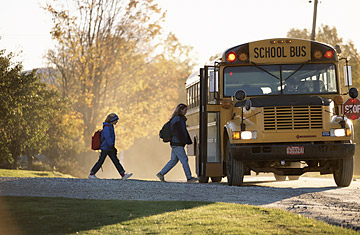
(2 of 3)
'Target them early'
Education in Waconda begins with preschool, which isn't mandatory but is free and open to all. About 90 percent of preschool-aged children enroll in the half-day program each year. The first year of the program, 17 out of 21 students came from one-parent households.Some come to school ready to read. Others can't recognize basic shapes or colors.
Preschool, which research has shown can have both short- and long-term benefits for students, is the first step in addressing these disparities. Waconda strives to have all of its students performing at or above grade-level by fourth grade. Students are screened when they enter preschool, and their progress is continually assessed through short diagnostic tests and teacher observations.
Each child has an assessment card that follows him or her from school entry to high-school graduation, tracking how well he or she has grasped every content standard in every subject area.
Walking around the computer lab, Palen knows exactly how her fourth-graders are doing as they work through a 10-question practice test to prepare for the approaching state exams.
Palen calls out reminders — "Remember, when we take the real test, I can read you the question, but you have to ask me" — and offers incentives to stay focused: "After this, you can go play cool math games."
Some raise their hands again; others cruise through without difficulty. All are able to tackle grade-level questions about plotting points with (x,y) coordinates.
"We do a lot of testing," said Palen, whose students will take practice tests about once a week in the months leading up to the state exams. "That's how we see where the kids are."
If any of the students aren't catching on, Waconda can offer a wealth of assessments to diagnose problems and subsequent one-on-one tutoring, either with specialist teachers or community volunteers.
"If we target them early, then we are able to close the gap early, rather than later when the gap is too big," says Jennifer Brummer, who teaches third and fourth grade at Tipton Community School.
The one-on-one attention doesn't disappear when students get to fourth grade. More programs kick in afterwards, including a chance to work directly with Title 1 teachers — those hired with federal funds distributed to schools based on the percentage of students eligible for free- or reduced-priced lunch — or spend more hours in after-school programs, where they can do homework and practice any skills they might be strugglingwith.
Jill Weber attributes her son Mason's success to the long hours he logs with teachers here. He's been going to the after-school program for three or four days a week since first grade, and now as a fifth-grader he stays in the building until 5 p.m.
"He just benefits really well from it," Weber says, citing Mason's recent "Excellence in Math" award in his class. "I don't think he would have gotten that if he hadn't got the extra help that these after-school teachers give."
The personalized interventions continue throughout high school. Students deemed at risk — typically, those with low grades or poor attendance — get extra attention outside the classroom or work on computer programs to practice specific skills and monitor their progress. One teacher at the high school spends her mornings working with small groups of students, sitting with them as they watch lessons on DVD to make up work they missed or failed to master, and grilling them with questions from the textbook.
"We all know all the kids here at our school," Brummer says. "We can identify what that child needs and really come up with a good strategy that works for that student. It's not just a name on a paper."
